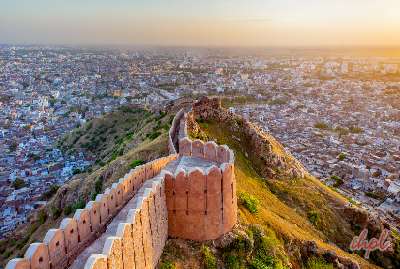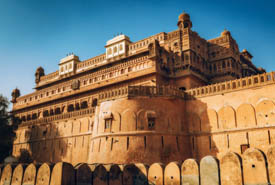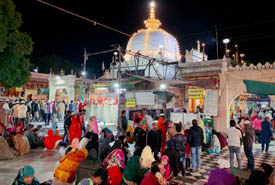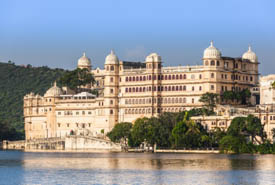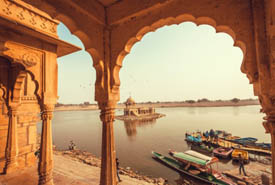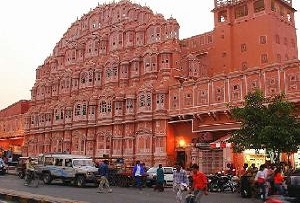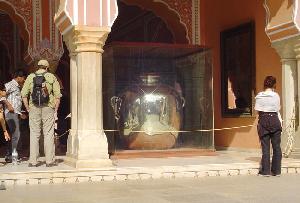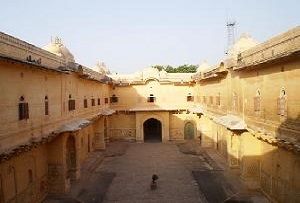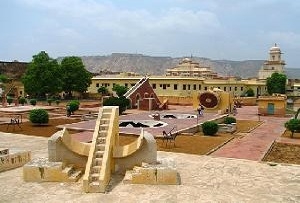Location: Gangori Bazaar, J.D.A. Market, Pink City, Jaipur
Timings: 9.30 am to 7:30 pm
Visit Duration: Approx 3 Hour
Entry Fee: No entry fee
Planning a Trip? Speak to an expert
A magnificent palace complex in the heart of Jaipur, the City Palace rightly reflects the rich culture of the Maharajas. It was the royal seat of the Maharaja of Jaipur, who belonged to the Kachwaha Rajput clan.
A few portions of the City Palace have been converted into museums and galleries to preserve the heritage of a bygone era. To your surprise, the royal family still resides at this palace.
There are three entrance gates: Virendra Pol, Udai Pol, and Tripolia Gate. Visitors can explore attractions such as Mubarak Mahal, Chandra Mahal, Pitam Niwas Chowk, Diwan-I-Khas, Diwan-E-Aam, and Maharani Palace.
Here is a Complete Guide to the City Palace in Jaipur, including information about the palace’s location, attractions, history, timing, and entry fee.
City Palace Jaipur History
Sawai Jai Singh of the Kachwaha Rajput clan built the City Palace. In the 17th century, when it was being constructed, he used it as a residence. He wanted Jaipur to become the capital of Rajasthan instead of Amber.
The design of the City Palace in Jaipur was laid out by the architects – Vidhyadhar Bhattacharya and Samuel Swinton Jacob. That is why you can see a European touch to the palace. Raja Man Singh II was the last king of the Kachwaha Dynasty who sat on the throne for the last time.
Architecture of City Palace
The City Palace in Jaipur showcases a marvellous blend of Rajput, Mughal, and European architecture. Built according to the principles of ‘Vastu Shastra’ and designed in a grid pattern, the palace has four gates for entry and exit: Tripolia Gate, Udai Pol, Virendra Pol, and Jaleb Chowk.
City Palace features numerous palaces, temples, terraces, balconies, gardens, courtyards, and patios, all adorned with intricate latticework, jali work, inlaid ornaments, and carved marble.
One of the most captivating parts of the City Palace is Pritam Niwas Chowk, which has four gates, each representing a different season. These remarkable features make the City Palace of Jaipur a true architectural marvel left behind by history.
Ready to plan your Jaipur itinerary? Start by exploring the top Tourist Places in Jaipur.
City Palace Location
The City Palace is located on Jaleb Chowk, opposite Jantar Mantar.
Address: Gangori Bazaar, J.D.A. Market, Pink City, Jaipur, Rajasthan 302002
City Palace Timings
The city palace is open from 9:30 a.m. to 6:00 p.m. (day) and 6:30 p.m. to 8:00 p.m. (night).
Palace opening and closing times can vary according to the season; check the official website before visiting.
Want more than just palaces? Jaipur has thrilling adventures, from hot air balloons to zip-lining.
City Palace Entry Fee
The palace is separated into the museum and the royal family residence. Therefore, you need to buy two separate tickets to explore each section. You can also take a combined ticket to visit both parts. Here are the entry charges to City Palace for Indian Nationals –
| Indian National/ Resident (All Prices In Indian Rupees) | |||||
| Museum | Composite | Museum Night | Royal Grandeur | Royal Splendour | |
| Included | All Palace Courts & Galleries
Still and small video camera without tripod |
All Palace Courts & Galleries
Jaigarh Royal Cenotaphs Still and small video camera without tripod |
Sculpture Lumiere All Palace Courts Selected Galleries
Still and small video camera without tripod |
Shobha Niwas , Pritam Niwas & Sarvato Roof. | Sri Niwas, Chavi Niwas, Shobha Niwas, Pritam Niwas & Sarvato Roof. |
| Adult | 300 | 400 | 500 | 1500 | 3000 |
| Child (5-12 years) | 150 | 250 | 250 | 1000 | 1500 |
| Senior citizen/ Defence | 150 | 250 | 380 | NA | NA |
| Foreign National/ Resident (All Prices In Indian Rupees) | ||||
| Composite | Museum Night | Royal Grandeur | Royal Splendour | |
| Included | All Palace Courts & Galleries
Jaigarh Royal Cenotaphs Still and small video camera without tripod |
Sculpture Lumiere
All Palace Courts Selected Galleries Still and small video camera without tripod, Audio guide, discount at Baradari Restaurant |
Shobha Niwas , Pritam Niwas & Sarvato Roof. | Sri Niwas, Chavi Niwas, Shobha Niwas, Pritam Niwas & Sarvato Roof. |
| Adult | 700 | 1000 | 2000 | 4000 |
| Child (5-12 years) | 400 | 500 | 1500 | 2000 |
| Senior Citizen | 400 | 500 | NA | NA |
City Palace Jaipur ticket price can vary depending on the season, so be sure to check the official site for prices before visiting.
Attractions at the City Palace
Many courtyards are inside the City Palace, and a temple is dedicated to Lord Krishna. Here is what is inside the City Palace in Jaipur –
The decorated gates of City Palace
This magnificent palace has four entrances: Tripolia Gate, Virendra Pol, Jalebi Chowk and Udai Pol. The main palace has four small gates, Pritam Niwas Chowk, which leads to the Chandra Mahal. People believe that these gates represent the four Hindu gods: Lord Vishnu, Lord Shiva, Goddess Parvati, and Lord Ganesha.
There is a Mor Gate to symbolize autumn, a Lotus Gate to represent summer, and a Leheriya Gate to represent spring. Last but not least, the Rose Gate is decorated with rose carvings and symbolizes the winter season.
Mubarak Mahal
Welcome Palace, or Mubarak Mahal, is built with a European touch. It has been converted into the Maharaja Sawai Mansingh Museum and showcases a collection of robes, Pashmina shawls, and Sanganeri block-print clothes.
Entrance Gates
The City Palace has several grand gates, including Tripolia Gate, Virendra Pol, and Udai Pol. Each gate of this royal complex combines Rajput and Mughal architectural styles.
Ready to embark on a Jaipur adventure? Discover our Jaipur Packages and start planning your dream trip today
Chandra Mahal
A grand peacock gate welcomes you to Chandra Mahal. This palace is known for its beautiful paintings and mirror embellishments that fascinate tourists. It is a seven-floored building with each given a different name – Sukh-Niwas, Mukut Mahal, Ranga Mandir, Pitam Niwas, Shri-Niwas, and Chhavi-Niwas (in no particular order). The kings used the Chhavi Niwas as their monsoon retreat. The ticket for Chandra Mahal has to be bought separately.
Pritam Niwas Chowk
The chowk features four smaller gates, each representing a different Hindu deity and a different season. As you enter the majestic Chandra Mahal, you can see a glimpse of Jaipur’s royal lifestyle.
Armory
Known as Anand Mahal Sileh Khana in earlier times, the armoury has an extensive collection of weapons used by Rajputs in wars. It includes daggers, rifles, knuckle braces, and more. Some of the weapons displayed in the armoury are from the 15th century.
Sukh Niwas
The complex contains a Sukh Niwas, also called the Hall of Rest, where the royal family have their dinner. You can see a variety of paintings and crystals here, including Lalique’s famous crystal dining table. Stunning craftsmanship reflects the luxury of the royal family on this table.
Baaghi Khana
This part of the City Palace has many royal rides and chariots that the royal family uses. The royal chariot was built in European style and was gifted by Queen Victoria in 1876 to Maharaja Sawai Ram Singh II.
Maharani Palace
The Maharani Palace was the residence of the queens of Jaipur. Its intricate designs and spacious rooms highlight the luxurious lifestyle of the royal ladies. The architecture is elegant and functional, providing comfort and privacy.
Looking for essential information on Jaipur? Our Jaipur Guide is your go-to resource.
Shobha Niwas
The stunning gold embellishments and intricate mirror work in Shobha Niwas make it a spectacular place to visit. In this room, hand-painted ceilings and ornate decorations reflect regal splendour, offering visitors a glimpse into the royal lifestyle of Jaipur.
Rajendra Pol
The Rajendra Pol is another entrance to the City Palace. It connects different sections throughout the palace and exhibits intricate architectural details typical of Rajasthani palaces.
The Clock Tower
City Palace’s clock tower is a historical landmark that signifies the keeping of time in royal Jaipur. Visitors can appreciate its historical significance and architectural beauty amid bustling markets.
Diwan-e-Khaas
Diwan-e-Khaas is a royal darbar that houses life-size paintings of the Jaipur Maharajas. The Maharaja used to hold private meetings with his courtiers at this place. The royal throne, called ‘Takht-e-Rawal,’ along with chairs, can be seen in this hall, which has beautiful gold and red ceilings.
The paintings on the walls also contain ancient texts, embroidered rugs, and handwritten original manuscripts of Hindu scriptures.
Are you interested in learning more about other fascinating monuments in Jaipur? Check out our comprehensive guide.
Peacock Gate
Another city palace attraction that attracts visitors’ attention is the Peacock Gate, which has a stunning peacock motif. It is a popular spot for photography because of its vibrant colours and intricate carvings, making it one of the complex’s most admired entrances.
Diwan-e-Aam (Sarvato Bhadra)
This is the first palace you will see when you enter the City Palace. It was used to hold meetings with the common public of Jaipur. The architecture of this hall is worth seeing. The magnificent crystal chandeliers hanging from the ceiling and two gigantic silver urns are present here.
Legend says that Maharaja Sawai Madho Singh II used these vessels to carry water from the holy river Ganges to England. Besides, the marble flooring and stalls where you can shop traditional Rajasthani dresses and handicrafts are not to be missed.
Govind Dev Ji Temple
This temple in City Palace is dedicated to Lord Krishna. It receives a large number of devotees every day and is thronged by people during the Janmashtami festival.
Rang Mandir
It is also known as the Hall of Color, known for its stunning mirror work on walls and ceilings. This area was used for royal celebrations and performances, showcasing vibrant colours that created an enchanting atmosphere for visitors.
Nearby Attractions
There are many monuments and attractions near city places such as:
- Jantar Mantar (100m – 3 min)
- Hawa Mahal (650m – 6 min)
- Albert Hall Museum (3.1km – 11min)
- Jal Mahal (4.9km – 16 min)
- Birla Mandir (4.8km – 16min)
Traveller Tips
Here are some things you must keep in mind while visiting City Palace in Jaipur –
- The place is fit for differently-abled people.
- Hire a local guide in the local language. You can also take an audio-guide tour.
- Wear comfortable shoes.
- You can shop for locally produced paintings and jewellery from the museums.
- Carry a water bottle.
- The palace tour will require 2 to 3 hours.
- There are certain places where you cannot click pictures.
- Visit City Palace between September and March as the weather is pleasant.
How to Reach City Palace
By train: If you’re travelling by train, get off at Jaipur Junction. City Palace is about 3.9 km from the station and takes around 20 minutes. You can easily find taxis or autos outside the station.
By air: The nearest airport is Jaipur International Airport, which is about 12.6 km away. A cab ride to City Palace takes around 30 minutes.
By road: The closest bus station is Sindhi Camp, about 2.6 km from the City Palace. From there, you can get cabs to the City Palace. Local buses can also be hired, which is a better option for budget travellers. Get down at Tripolia Bazaar or Badi Chopar, where you can walk to City Palace.
Best Time to Visit City Palace
No matter the time of year, the City Palace always looks pristine. However, you must walk a lot because the complex is spread across many acres. City Palace Jaipur is best visited between October and February, the winter season. During winter, the Rose Gate of the City Palace is a sight to watch, which depicts the beauty of winter and is dedicated to the Female Goddess.
Jaipur Tour Packages
Things To Do in Jaipur
- Rajasthan Tour Packages
- Rajasthan Tourism
- Best Time to Visit Rajasthan
- How to Reach Rajasthan
- Cities In Rajasthan
- Ajmer Tourism
- Accommodation in Ajmer
- History of Ajmer
- Alwar Tourism
- History of Alwar
- Accommodation in Alwar
- Banswara Tourism
- Baran Tourism
- Bharatpur Tourism
- Bikaner Tourism
- Shopping in Bikaner
- Bundi Tourism
- Chittorgarh Tourism
- Dungarpur Tourism
- Ganganagar Tourism
- Ghanerao Tourism
- Hanumangarh Tourism
- Jaipur Tourism
- Arts and Crafts in Jaipur
- Jaipur Temperature
- Cuisine in Jaipur
- Entertainment in Jaipur
- History of Jaipur
- Jaisalmer Tourism
- History of Jaisalmer
- Jhalawar Tourism
- Jodhpur Tourism
- Entertainment in Jodhpur
- History of Jodhpur
- Khimsar Tourism
- Kota Tourism
- Mandawa Tourism
- History of Mandawa
- Mount Abu Tourism
- History of Mount Abu
- Pushkar Tourism
- Udaipur Tourism
- Entertainment in Udaipur
- History of Udaipur
- Rohet Tourism
- Samode Tourism
- Sawai Madhopur Tourism
- Shekhawati Tourism
- Gangaur Festival, Jaipur
- Jaipur Literature Festival
- Teej Festival in Jaipur
- Rajasthan International Folk Festival
- Pushkar Fair 2024
- Fairs and Festivals in Rajasthan
- Alwar Festival Rajasthan
- Baneshwar Fair Dungarpur, Rajasthan
- Banganga Fair
- Brij Festival Bharatpur
- Bundi Utsav in Rajasthan
- Camel Festival in Bikaner
- Chandrabhaga Fair Jalawar, Rajasthan
- Jaisalmer Desert Festival
- Flamenco & Gypsy Festival in Jodhpur
- Gogamedi Fair Rajasthan
- Holi in Rajasthan
- International Kite Festival Jaipur
- Kaila Devi Fair
- Kajli Teej Festival Bundi, Rajasthan
- Kalbelia Dance Festival Rajasthan
- Kallaji Fair Banswara, Rajasthan
- Karni Mata Mela Bikaner
- Kolayat Fair Bikaner
- Mahaveerji Fair Rajasthan
- Marwar Festival Jodhpur
- Mewar Festival Udaipur
- Nagaur Fair Rajasthan
- Shekhawati Festival Rajasthan
- Shilpgram Mela Udaipur
- Summer Festival in Mount Abu
- Teej Festival Jaipur
- Winter Festival Mount Abu
- Udaipur World Music Festival
- Adventure Activities in Rajasthan
- Art and Crafts in Rajasthan
- Bhavai Dance of Rajasthan
- Block Printing Rajasthan
- Blue Pottery Rajasthan
- Dandiya Dance Rajasthan
- Enamel Jewellery of Rajasthan
- Fresco Paintings Rajasthan
- Ghoomar Dance Rajasthan
- Jaipuri Quilt (Razai)
- Kachi Ghodi Dance Rajasthan
- Kathputli Dance Rajasthan
- Maand Folk Music Rajasthan
- Pabuji Ki Phach Folk Music Rajasthan
- Folk Dances & Arts of Rajasthan
- Raagmala Paintings Rajasthan
- Art and Crafts of Rajasthan
- Silver Jewellery Rajasthan
- Terah Taal Dance Rajasthan
- Bandhej and Leheria Art- Tie & Dye Rajasthan
- Wood and Marble Carving Rajasthan
- Climate of Rajasthan
- Rajasthani Cuisine
- Influences on Rajasthani Cuisine
- Popular Rajasthani Delicacies
- Cultural Centers in Rajasthan
- Desert Cultural Center Jaisalmer
- Jawahar Kala Kendra Jaipur
- Rajasthan Culture and Tradition
- Entertainment in Rajasthan
- History of Rajasthan
- Luxury Trains in Rajasthan
- Night Life in Rajasthan
- Travel to Rajasthan by Air
- Travel to Rajasthan by Rail
- Travel to Rajasthan by Road
- Restaurants in Rajasthan
- Shopping in Rajasthan
- Sights in Rajasthan
- Tourist Attractions in Ajmer
- Places to Visit Near Ajmer
- Tour to Kishangarh
- Tour to Nasirabad
- Tour to Pushkar
- Forts and Palaces in Ajmer
- Akbar Palace & Museum in Ajmer
- Taragarh Fort in Ajmer
- Lakes and Gardens in Ajmer
- Ana Sagar Lake in Ajmer
- Subhash Bagh in Ajmer
- Monuments in Ajmer
- Adhai Din Ka Jhopra in Ajmer
- Mayo College Ajmer
- Museums in Ajmer
- Ajmer Government Museum
- Religious Places in Ajmer
- Ajmer Sharif Dargah
- Nasiyan Jain Temple
- Tourist Attractions in Alwar
- Bazaars in Alwar
- Bazaza Bazaar in Alwar
- Malakhera Bazaar in Alwar
- Excursions from Alwar
- Places to Visit in Kesroli
- Places to visit in Neemrana
- Forts and Palaces in Alwar
- Alwar Fort
- Bala Quila in Alwar
- City Palace in Alwar
- Vijay Mandir Palace in Alwar
- Lakes and Gardens in Alwar
- Siliserh Lake
- Historical Monuments in Alwar
- Bhangarh Fort in Alwar
- Moosi Maharani ki Chhatri
- Tomb of Fateh Jang in Alwar
- Museums in Alwar
- Alwar Government Museum in Alwar
- Temples in Alwar
- Bhartrihari Temple in Alwar
- Jain Temple in Alwar
- Shiva Temple in Alwar
- Places to Visit in Bharatpur
- Bharatpur Bird Sanctuary
- Excursions from Bharatpur
- Tour to Bandh Baretha
- Tour to Bayana
- Tour to Deeg Palace
- Tour to Kaman
- Tour to Roopvaas
- Lohagarh Fort Bharatpur
- Temples in Bharatpur
- Banke Bihari Temple in Bharatpur
- Ganga Maharani Temple Bharatpur
- Laxman Temple Bharatpur
- Tourist Attractions in Bikaner
- Bazaars in Bikaner
- Kote Gate Bikaner
- Places to Visit Near Bikaner
- Deshnok
- Tour to Kolayat
- Forts and Palaces in Bikaner
- Junagarh Fort
- Lallgarh Palace in Bikaner
- Monuments in Bikaner
- Devi Kund in Bikaner
- Museums in Bikaner
- Ganga Government Museum Bikaner
- Prachina Cultural Centre & Museum in Bikaner
- Temples in Bikaner
- Bhandasar Jain Temple Bikaner
- Deshnok Temple in Bikaner
- Shiv Bari Temple Bikaner
- Tourist Attraction in Bundi
- Shopping in Bundi
- Main Bazaar in Bundi
- Tour to Bijolia
- Forts and Palaces in Bundi
- Bundi Palace
- Sukh Mahal in Bundi
- Taragarh Fort Bundi
- Lakes and Gardens in Bundi
- Jait Sagar Lake in Bundi
- Nawal Sagar Lake in Bundi
- Raniji ki Baori in Bundi
- Monuments in Bundi
- Chaurasi Khambon Ki Chhatri in Bundi
- Dabhai Kund in Bundi
- Ratan Daulat in Bundi
- Tourist Attractions in Chittorgarh
- Shopping in Chittorgarh
- Fort Road Market Chittorgarh
- Rana Sanga Market Chittorgarh
- Sadar Bazaar Chittorgarh
- Excursions from Chittorgarh
- Forts and Palaces in Chittorgarh
- Chittorgarh Fort Rajasthan
- Fort Fateh Prakash Palace, Chittorgarh
- Padmini’s Palace Chittorgarh
- Rana Kumbha Palace Chittorgarh
- Gardens in Chittorgarh
- Chittorgarh Fort Gardens
- Padmini’s Gardens Chittorgarh
- Monuments in Chittorgarh
- Chhatris of Jaimal and Kalla Chittorgarh
- Kirti Stambh Chittorgarh
- Vijay Stambh Chittorgarh
- Museums in Chittorgarh
- Archeological Museum Chittorgarh
- Fateh Prakash Palace Museum Chittogarh
- Temples in Chittorgarh
- Kalika Mata Temple Chittorgarh
- Kumbha Shyam Temple Chittorgarh
- Meera Temple Chittorgarh
- Tourist Attractions in Dungarpur
- Tourist Attractions in Ghanerao
- Places to Visit in Jaipur
- Shopping in Jaipur
- Aravali Bazaar in Jaipur
- Bapu Bazaar in Jaipur
- Chandpole Bazar in Jaipur
- Gaurav Tower Bazaar in Jaipur
- Johari Bazaar in Jaipur
- Kishanpole Bazar in Jaipur
- Nehru Bazar in Jaipur
- Sireh Deori Bazaar in Jaipur
- Tibbati Bazaar in Jaipur
- Tripolia Bazaar in Jaipur
- Chokhi Dhani in Jaipur
- Excursion From Jaipur
- Forts in Jaipur
- Amber Fort
- City Palace in Jaipur
- Jaigarh Fort in Jaipur
- Nahargarh Fort, Jaipur
- Gardens in Jaipur
- Jai Niwas Garden in Jaipur
- Kanak Vrindavan Garden in Jaipur
- Ram Niwas Bagh in Jaipur
- Sisodia Rani ka Bagh, Jaipur
- Vidyadhar Garden Jaipur
- Monuments in Jaipur
- Gatore ki Chhatriyan Jaipur
- Hawa Mahal Jaipur
- Jal Mahal Jaipur
- Jantar Mantar Jaipur
- Museums in Jaipur
- Albert Hall Museum Jaipur
- Birla Planetarium Jaipur
- Dolls Museum Jaipur
- Wax Museum Jaipur
- Rambagh Golf Club
- Snow Planet Jaipur
- Temples in Jaipur
- Birla Temple Jaipur
- Galtaji Temple Jaipur
- Govind Dev Ji Temple Jaipur
- Moti Dungri Ganesh Ji Temple
- Tourist Attractions in Jaisalmer
- Shopping in Jaisalmer
- Bhatia Bazaar in Jaisalmer
- Sadar Bazaar in Jaisalmer
- Dune Bashing in Jaisalmer
- Places To Visit In And Around Jaisalmer
- Excursions from Jaisalmer to Barmer
- Excursions from Jaisalmer to Khichan
- Places to Visit in Pokhran
- Famous Forts in Jaisalmer
- Jaisalmer Fort
- Tazia Tower in Jaisalmer
- Gadsisar Lake in Jaisalmer
- Havelis in Jaisalmer
- Nathmal Ki Haveli in Jaisalmer
- Patwon ki Haveli in Jaisalmer
- Salim Singh ki Haveli
- Monuments and Havelis in Jaisalmer
- Museums in Jaisalmer
- Desert Culture Centre and Museum
- Quad Biking in Jaisalmer
- Sand Dunes in Jaisalmer
- Khuri Sand Dunes in Jaisalmer
- Sam Sand Dunes
- Temples in Jaisalmer
- Jain Temples in Jaisalmer
- Lakshminath Temple in Jaisalmer
- Lodurva Temple in Jaisalmer
- Places to Visit in Jodhpur
- Shopping in Jodhpur
- Kapra Bazaar in Jodhpur
- Mochi Bazaar in Jodhpur
- Sarafa Bazaar in Jodhpur
- Excursions from Jodhpur
- Flying Fox in Jodhpur
- Forts, Palaces and Cenotaphs in Jodhpur
- Mehrangarh Fort, Jodhpur
- Umaid Bhawan Palace in Jodhpur
- Gardens in Jodhpur
- Mandore Garden in Jodhpur
- Nehru Park in Jodhpur
- Umed Garden in Jodhpur
- Monuments in Jodhpur
- Jaswant Thada in Jodhpur
- Museums in Jodhpur
- Sardar Government Museum in Jodhpur
- Paragliding at Jodhpur
- Temples in Jodhpur
- Baba Ramdev Temple in Jodhpur
- Mahamandir Temple in Jodhpur
- Udai Mandir in Jodhpur
- Tourist Attractions in Kanota
- Tourist Attractions in Kota
- Main Bazaar Kota, Rajasthan
- Excursions from Kota
- Tour to Baroli
- Forts and Palaces in Kota
- City Fort Palace in Kota
- Jagmandir Palace Kota, Rajasthan
- Phool Sagar in Kota
- Taragarh Fort
- Lakes and Gardens in Kota
- Kesar Bagh in Kota
- Kishore Sagar Lake
- Sar Bagh in Kota
- Monuments and Havelis in Kota
- Haveli of Deaji
- Haveli of Devta Shridharji in Kota
- Museums in Kota
- Brij Vilas Palace Museum in Kota
- Raja Madho Singh Museum Kota
- Temples in Kota
- Kansua Temple Kota, Rajasthan
- Mathuradheesh Temple Kota
- Places to Visit in Mandawa
- Shopping in Mandawa
- Main Bazaar Mandawa
- Tour to Jhunjhunu
- Tour to Mukandgarh
- Tour to Ramgarh
- Forts in Mandawa
- Mandawa Fort Mandawa
- Monuments and Havelis in Mandawa
- Binsidhar Newatia Haveli Mandawa
- Goenka Chattri Mandawa
- Goenka Double Haveli Mandawa
- Gulab Rai Ladia Haveli
- Hanuman Prasad Goenka Haveli Mandawa
- Jhunjhunwala Haveli Mandawa
- Murmuria Haveli Mandawa
- Temples in Mandawa
- Thakurji Temple Mandawa
- Places to Visit in Mount Abu
- Shopping in Mount Abu
- Khadi Bazaar Mount Abu
- Forts and Palaces in Mount Abu
- Achalgarh Fort Mount Abu
- Kesar Bhawan Palace Mount Abu
- Sunrise Palace Mount Abu
- Lakes in Mount Abu
- Nakki Lake Mount Abu
- Monuments in Mount Abu
- Honeymoon Point in Mount Abu
- Sunset Point in Mount Abu
- The Crags Mount Abu
- Museums in Mount Abu
- Archeological Museum Mount Abu
- Brahma Kumaris Spiritual University and Museum Mount Abu
- Government Museum Mount Abu
- Temples in Mount Abu
- Adhar Devi Temple Mount Abu
- Dilwara Jain Temple Mount Abu
- Gaumukh Temple Mount Abu
- Luna Vashi Temple Mount Abu
- Mahaveer Swami Temple in Mount Abu
- Shri Raghunatji Temple Mount Abu
- Vimala Vashi Temple Mount Abu
- Tourist Attractions in Nawalgarh
- Places to Visit in Pushkar
- Bazaar in Pushkar
- Camel Safari in Pushkar
- Excursions from Pushkar
- Tour to Ajmer from Pushkar
- Tour to Kishangarh from Pushkar
- Tour to Kuchaman from Pushkar
- Tour to Roopangarh from Pushkar
- Forts and Palaces in Pushkar
- Man Mahal in Pushkar
- Pushkar Palace
- Pushkar Lake
- Temples in Pushkar
- Apteshwar Temple in Pushkar
- Brahma Temple in Pushkar
- Gayatri Mata Temple in Pushkar
- Mahadeva Temple in Pushkar
- Rangji Temple in Pushkar
- Raghunath Temple in Pushkar
- Sri Rama Vaikunth Temple in Pushkar
- Saraswati Temple in Pushkar
- Savitri Mata Temple in Pushkar
- Varaha Temple in Pushkar
- Best Places to Visit in Rajasthan
- Adventures Activities in Rajasthan
- Camping in Rajasthan
- Cycling in Rajasthan
- Hot Air Balloon Rides in Rajasthan
- Wildlife Safari in Rajasthan
- Forts & Palaces in Rajasthan
- Badnore Fort Bhilwara
- City Palace Karauli, Rajasthan
- Deogarh Mahal near Udaipur
- Dundlod Fort Jhunjhunu, Rajasthan
- Khimsar Fort Khimsar, Rajasthan
- Kumbhalgarh Fort
- Laxmangarh Fort Sikar, Rajasthan
- Madhogarh Fort Jaipur
- Mandalgarh Fort Bhilwara, Rajasthan
- Rohet Fort
- Deeg Palace, Bharatpur
- Havelis in Rajasthan
- Aath Haveli Nawalgarh, Rajasthan
- Anandilal Poddar Haveli Nawalgarh
- Bhagirath Mal Goenka Haveli Dundlod
- Bhagton ki Choti Haveli Nawalgarh
- Char Chowk Haveli Laxmangarh
- Chetram Sanganeeria Haveli Laxmangarh
- Chhauchharia Haveli Nawalgarh, Rajasthan
- Chokhani Double Haveli Mandawa
- Choudaharia Haveli Fatehpur
- Dharni Dhakra Haveli Nawalgarh
- Gauri Shankar Haveli Fatehpur
- Geevrajka Haveli Nawalgarh
- Harkishan Das Saraogi Haveli Fatehpur, Rajasthan
- Haveli Nadine Fatehpur, Rajasthan
- Hem Raj Kulwal Haveli Nawalgarh, Rajasthan
- Hira Lal Sarowgi Haveli
- Hodh Raj Patodia Haveli Nawalgarh
- Jagannath Singhania Haveli Fatehpur, Rajasthan
- Kaniram Narsinghdas Tibrewal Haveli Jhunjhunu
- Kanoria Haveli Mukandgarh
- Lakshminarayan Ladia Haveli Mandawa
- Mahaveer Prasad Goenka Haveli Fatehpur
- Mantri Haveli Churu, Rajasthan
- Modi Haveli Jhunjhunu, Rajasthan
- Mohan Lal Saraf Haveli Mandawa, Rajasthan
- Mohanlal Ishwardas Haveli Jhunjhunu, Rajasthan
- Muraraka Haveli Nawalgarh
- Narudin Farooqi Haveli Jhunjhunu
- Parusrampuria Haveli Nawalgarh
- Saraf Haveli Mukundgarh, Rajasthan
- Shyonarayan Kyal Haveli Laxmangarh, Rajasthan
- Sunheri Kothi Tonk, Rajasthan
- Vishnunath Keria Haveli Fatehpur, Rajasthan
- Hill Forts in Rajasthan
- Lakes & Gardens in Rajasthan
- Nehru Garden Udaipur
- Monuments in Rajasthan
- Ghanta Ghar Laxmangarh
- Hathi Bhata Tonk, Rajasthan
- Museums in Rajasthan
- Bharatiya Lok Kala Mandal in Udaipur
- Government Museum Jaisalmer
- Rajasthan State Archives Bikaner
- Udaipur Solar Observatory Udaipur
- Religious Sites in Rajasthan
- Achalgarh Shiva Temple Mount Abu
- Ambika Mata Temple Udaipur
- Charbhuja Mandir Bhilwara, Rajasthan
- Harni Mahadev Bhilwara Rajasthan
- Jain Temple Ranakpur
- Karni Mata Temple- Temple of Rats
- Laxminath Temple Bikaner
- Osiyan Temple Near Jodhpur
- Parshvanath Temple Nakoda, Rajasthan
- Radha Murlimanohar Temple Laxmangarh, Rajasthan
- Raj Ratan Bihari and Rasik Siromani Temple Bikaner
- Ranakpur Temple Udaipur
- Rani Sati Temple Jhunjhunu
- Rishabdevji Temple Dhulev, Rajasthan
- Satyanarayan Temple Dundlod
- Sawai Bhoj Temple Bhilwara, Rajasthan
- Shri Ramdev Temple
- Shrinathji Temple Nathdwara
- Safaris in Rajasthan
- Camel Safari in Rajasthan
- Horse Safari in Rajasthan
- Jeep Safari in Rajasthan
- Wildlife in Rajasthan
- Bharatpur Bird Sanctuary
- Places to Visit in Samode
- Shopping in Samode
- Main Bazaar Samode, Rajasthan
- Forts and Palaces in Samode
- Samode Fort Samode
- Samode Palace
- Gardens in Samode
- Samode Bagh
- Monuments and Havelis in Samode
- Samode Haveli
- Temples in Samode
- Govind Devji Temple Samode
- Lord Hanuman Temple Samode
- Mahadeva Temple Samode
- Tourist Attractions in Sariska
- Hanuman Temple Sariska
- Kankawadi Fort Sariska
- Tourist Attractions in Sawai Madhopur
- Forts in Sawai Madhopur
- Khandar Fort Sawai Madhopur
- Ranthambore Fort
- Ranthambore National Park
- Temples in Sawai Madhopur
- Chamatkar Temple Sawai Madhopur
- Chauth Mata Temple Sawai Madhopur
- Kala Gaura Bhairava Temple Sawai Madhopur
- Places to Visit in Udaipur
- Shopping in Udaipur
- Chetak Circle
- Excursions from Udaipur
- Forts and Palaces in Udaipur
- City Palace Udaipur
- Fateh Prakash Palace Udaipur
- Lake Palace Udaipur
- Shiv Niwas Palace Udaipur
- Lakes in Udaipur
- Fateh Sagar Lake Udaipur
- Jaisamand Lake Udaipur
- Lake Pichola Udaipur
- Rajsamand Lake in Udaipur
- Saheliyon ki Bari Udaipur
- Monsoon Palace Udaipur
- Monuments and Havelis in Udaipur
- Bagore ki Haveli Udaipur
- Maharana Pratap Memorial Udaipur
- Museums in Udaipur
- Ahar Museum Udaipur
- City Palace Museum Udaipur
- Shilpgram Museum Udaipur
- Temples in Udaipur
- Amba Mata Temple Udaipur
- Bohra Ganesh Temple Udaipur
- Eklingji Temple Udaipur
- Jag Mandir Palace Udaipur
- Jagat Ambika Mata Temple Udaipur
- Jagdish Temple Udaipur
- Kankroli Temple Udaipur
- Karni Mata Temple Udaipur
- Mahakaleshwar Temple Udaipur
- Mahalaxmi Temple Udaipur
- Meera Kala Mandir Udaipur
- Nathdwara Temple Udaipur
- Neemach Mata Temple Udaipur
- Shrinathji Temple Udaipur
- Ranakpur Temple Udaipur
- Rishabhdeo Temple Udaipur
- Sagas Ji Bavji Temple Udaipur
- Best time to visit Bharatpur Bird Sanctuary
- Best time to visit Ranthambore National Park







